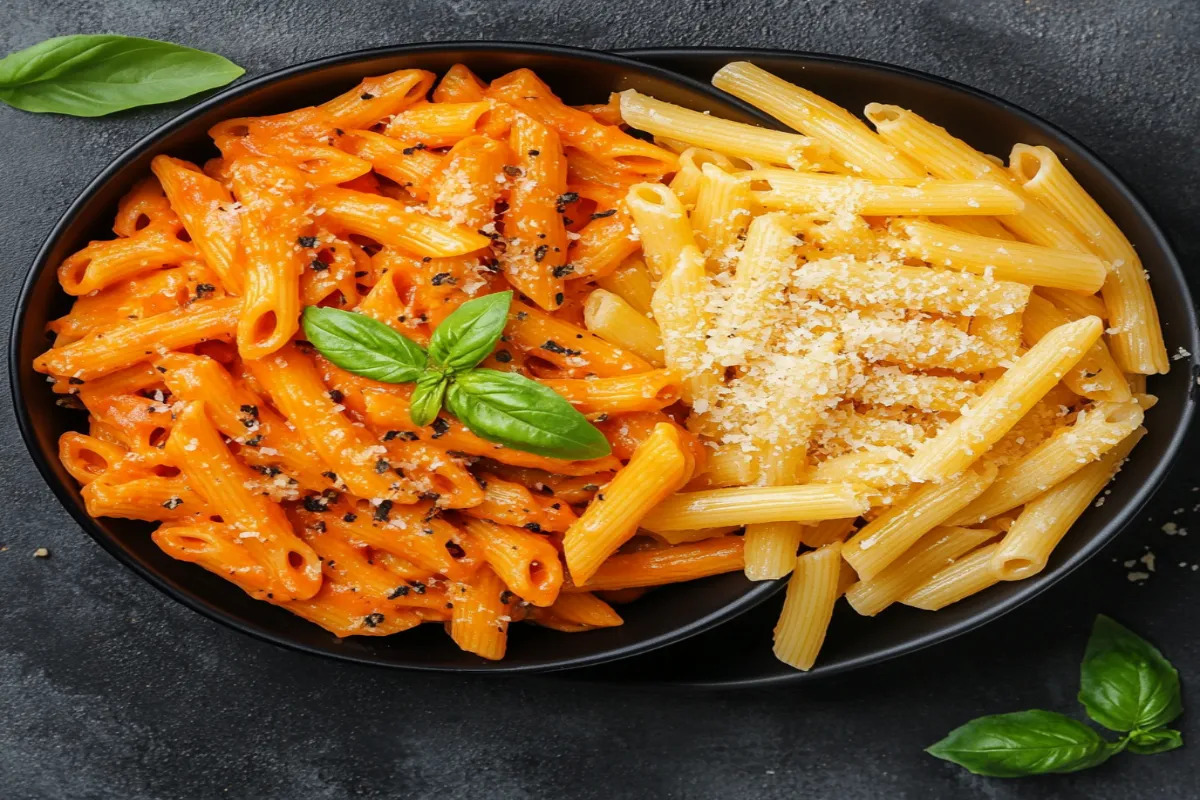When it comes to pasta, the variety of shapes and sizes is vast, each serving a specific purpose in the kitchen. Two of the most common pasta types are macaroni and penne, which differ in both shape and usage. Understanding these differences can help you choose the right pasta for your dish and enhance the flavor and texture of your meals.
In this article, we’ll break down the key differences between macaroni and penne, from their origin to their ideal uses, and provide helpful tips for using these pasta types in your kitchen.
What is Macaroni?
Origin of Macaroni
Macaroni has its roots in Italy and has become a staple in many global cuisines, particularly in North America, where it’s famously used in mac and cheese. This small, tube-shaped pasta has been a go-to for comfort food dishes for generations.
Macaroni’s Shape and Texture
Macaroni is a small, curved pasta that has a smooth surface, which makes it perfect for dishes with creamy or light sauces. Its small size allows it to mix well with other ingredients and absorb flavors, making it a great choice for cheesy or cream-based dishes like mac and cheese. If you’re looking for a classic baked macaroni and cheese recipe, check out this guide on old-fashioned macaroni and cheese.
Popular Uses of Macaroni
While mac and cheese is the most iconic dish made with macaroni, this pasta is also a popular choice for pasta salads and casseroles. It works well in cold dishes where its small size blends easily with other ingredients. Macaroni also pairs beautifully with a variety of sauces, particularly those that are creamy or cheesy. To elevate your dish, learn more about choosing the best cheese for bread and macaroni here.
Cooking Characteristics of Macaroni
Macaroni typically cooks quickly—about 7-9 minutes to al dente. It’s important to avoid overcooking macaroni, as it can become too soft and lose its structure. Its smooth surface allows it to absorb sauces evenly, making it ideal for cream-based dishes.
What is Penne?
Origin of Penne
Penne is another classic Italian pasta, known for its versatility in hearty dishes. The name “penne” comes from the Italian word for “pen,” inspired by the shape of the pasta, which resembles the nib of a fountain pen. Penne is a bit heartier than macaroni and is typically used in more robust, savory dishes.
Penne’s Shape and Texture
Penne is larger than macaroni and has a straight, tubular shape with ridges along the sides. These ridges make it perfect for holding onto thick, chunky sauces like marinara or pesto. The pasta is available in two varieties: penne rigate (with ridges) and penne lisce (smooth). The ridged version is the most popular, as it allows sauces to cling better to the pasta.
Popular Uses of Penne
Penne is widely used in baked dishes and casseroles, where it holds up well under heat. It’s also a great option for pairing with hearty meat or vegetable sauces. Penne Arrabbiata is a popular dish that features the pasta in a spicy tomato sauce. For a heartier meal, try it in a baked dish with cheese, where the penne rigate captures the sauce and ingredients beautifully.
If you’re curious about the best way to mix penne and macaroni in recipes, this article on mixing penne and macaroni will offer you some great tips and recipe ideas: Mix Penne and Macaroni.
Cooking Characteristics of Penne
Because of its size, penne typically takes longer to cook than macaroni, requiring around 10-12 minutes to reach al dente. The ridges on the pasta help it hold up in robust dishes and baked recipes, making it a popular choice for meals that feature thicker sauces.
Key Differences Between Macaroni and Penne
While both macaroni and penne belong to the tube-shaped pasta family, they have several key differences that make them suitable for different types of dishes.
Shape and Size
- Macaroni is smaller, often curved, and smooth, while penne is larger, straight, and ridged. The size difference affects the way they interact with sauces and other ingredients in a dish.
Texture and Surface
- Penne has ridges, which allow it to cling better to chunky or hearty sauces. Macaroni, with its smooth surface, is better for absorbing creamy, rich sauces like cheese.
Sauce Compatibility
- Penne works best with thick, chunky sauces, while macaroni is ideal for smooth, creamy sauces. This makes penne perfect for dishes like baked pasta or penne alla vodka, while macaroni shines in dishes like mac and cheese or cold pasta salads.
Cooking Times
- Macaroni typically cooks faster than penne, with an average cook time of 7-9 minutes compared to penne‘s 10-12 minutes.
Dish Variety
- Macaroni is often used in comfort food dishes like mac and cheese and cold pasta salads, while penne is more versatile and found in heartier baked dishes, casseroles, and with thick, flavorful sauces.
Nutritional Comparison
Both macaroni and penne are made from similar ingredients—primarily durum wheat semolina. However, there are some nutritional considerations to keep in mind when choosing between the two.
Nutritional Profiles of Macaroni and Penne
- Both macaroni and penne offer similar amounts of calories, carbohydrates, and protein. If you’re looking for a healthier option, consider using whole-grain versions of either pasta, which contain more fiber and nutrients.
Whole Grain and Gluten-Free Options
- Whole grain penne and macaroni are better choices for those looking to increase fiber intake. Additionally, gluten-free versions of both pastas are available for those with gluten sensitivities or dietary restrictions. To learn more about the benefits of whole grain pasta, check out this guide.
Best Recipes for Macaroni and Penne
Both pasta types are versatile and can be used in a wide range of dishes. Here are some of the best recipes to showcase the unique qualities of macaroni and penne.
Best Macaroni Recipes
- Classic Mac and Cheese: This creamy, cheesy dish is the ultimate comfort food, perfect for any occasion. Macaroni‘s smooth texture pairs perfectly with the rich cheese sauce.
- Macaroni Salad: A cool, refreshing pasta salad made with macaroni, vegetables, and a tangy dressing. This dish is a favorite for picnics and barbecues.
Best Penne Recipes
- Penne Arrabbiata: This spicy tomato-based dish is a favorite in Italian cuisine, and penne rigate is the perfect pasta to hold the fiery sauce.
- Baked Penne with Cheese: A hearty, baked pasta dish that combines penne with marinara sauce, cheese, and vegetables for a satisfying meal.

Can You Mix Macaroni and Penne?
Mixing macaroni and penne in the same dish can be a fun way to create unique textures and flavors. However, because of the difference in cooking times, it’s important to adjust your preparation accordingly.
Cooking Time Differences
- Because penne takes longer to cook than macaroni, you may need to either stagger their cooking times or cook them separately to ensure both reach the right consistency.
Popular Mixed Pasta Dishes
- Mixing pasta shapes is common in baked dishes and casseroles, where the variety of textures adds interest to each bite. Combining penne and macaroni works particularly well in hearty, cheesy dishes that benefit from both pasta shapes’ ability to hold sauces.
Frequently Asked Questions (FAQs)
What is the difference between macaroni and penne pasta?
Macaroni is smaller and smooth, while penne is larger and has ridges, making them suited to different sauces and dishes.
Which is better for mac and cheese, penne or macaroni?
While macaroni is the traditional choice for mac and cheese due to its smooth texture and size, penne can be used for a chunkier, heartier variation.
Can I substitute macaroni for penne in recipes?
Yes, you can substitute macaroni for penne, but keep in mind the differences in texture and cooking time.
Do different pasta shapes taste different?
While the ingredients are the same, different shapes provide unique textures and affect how the sauce clings to the pasta, which can influence the overall taste experience.
Conclusion
Both macaroni and penne are beloved pasta shapes, each with its own strengths. Macaroni excels in creamy, cheesy dishes, while penne is ideal for heartier meals with thick, chunky sauces. Understanding the differences in size, shape, and texture allows you to choose the best pasta for your recipe, ensuring a delicious and satisfying dish.
For more great recipes and tips on using these two pasta types, be sure to explore Rihanna Recipes.

